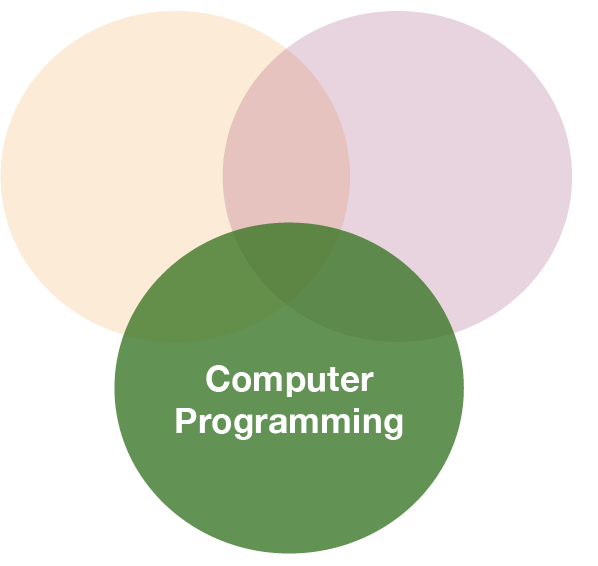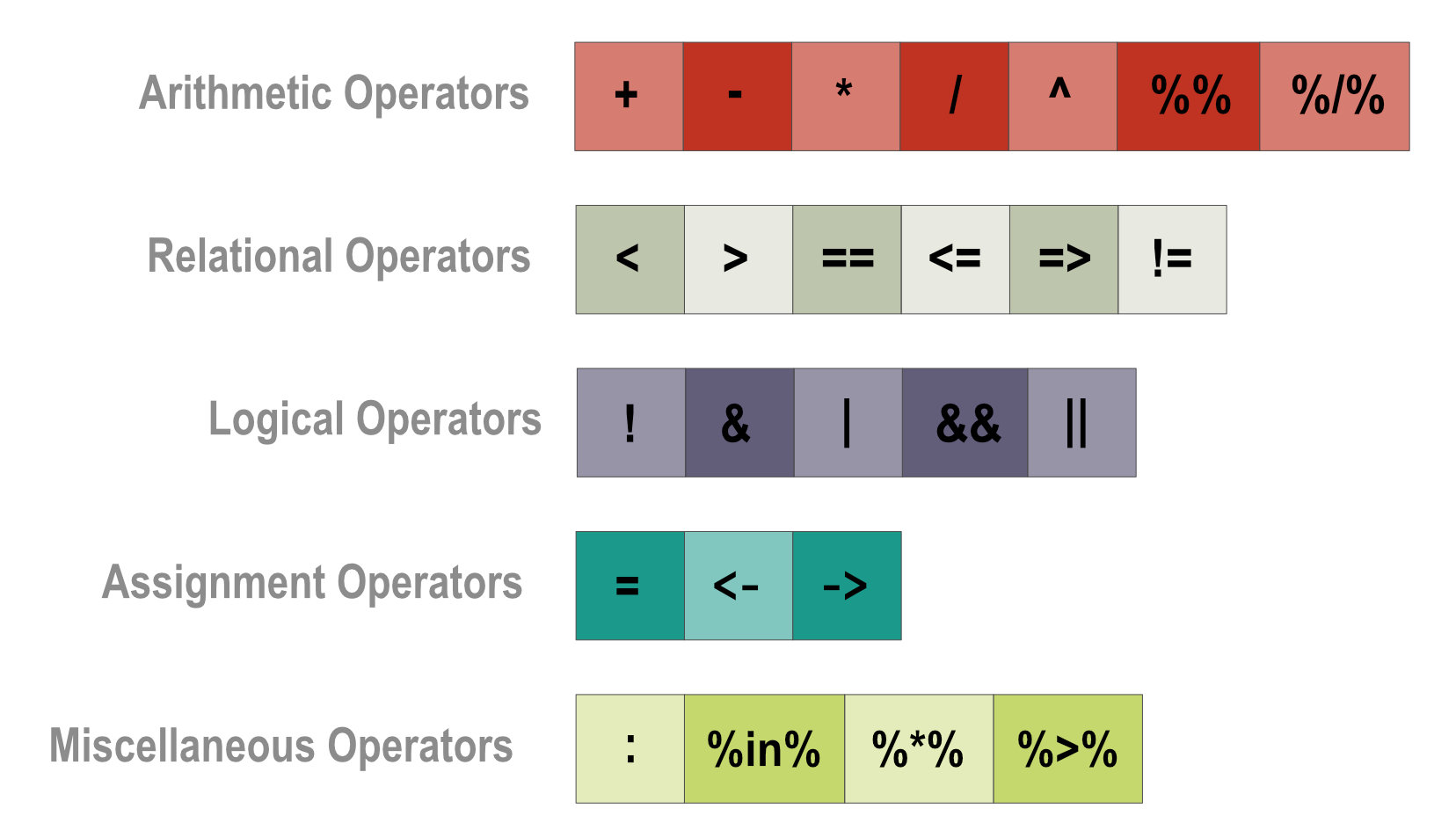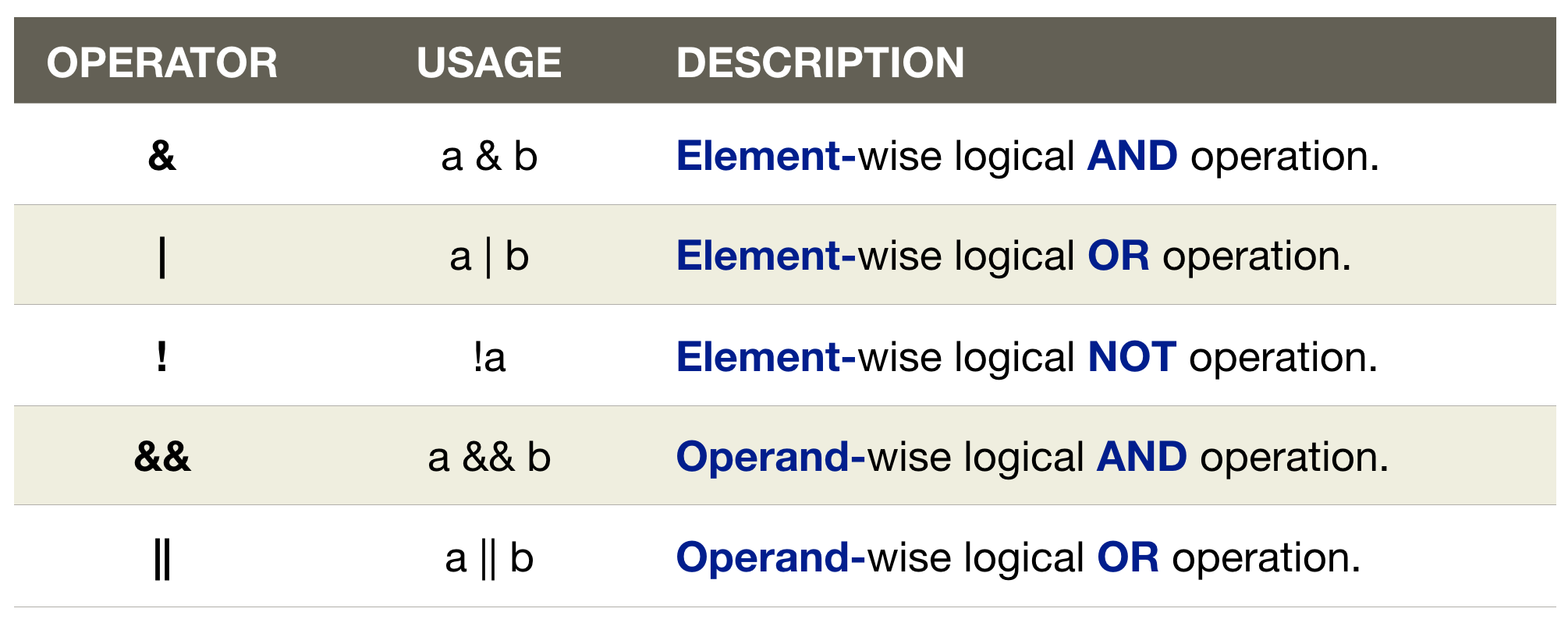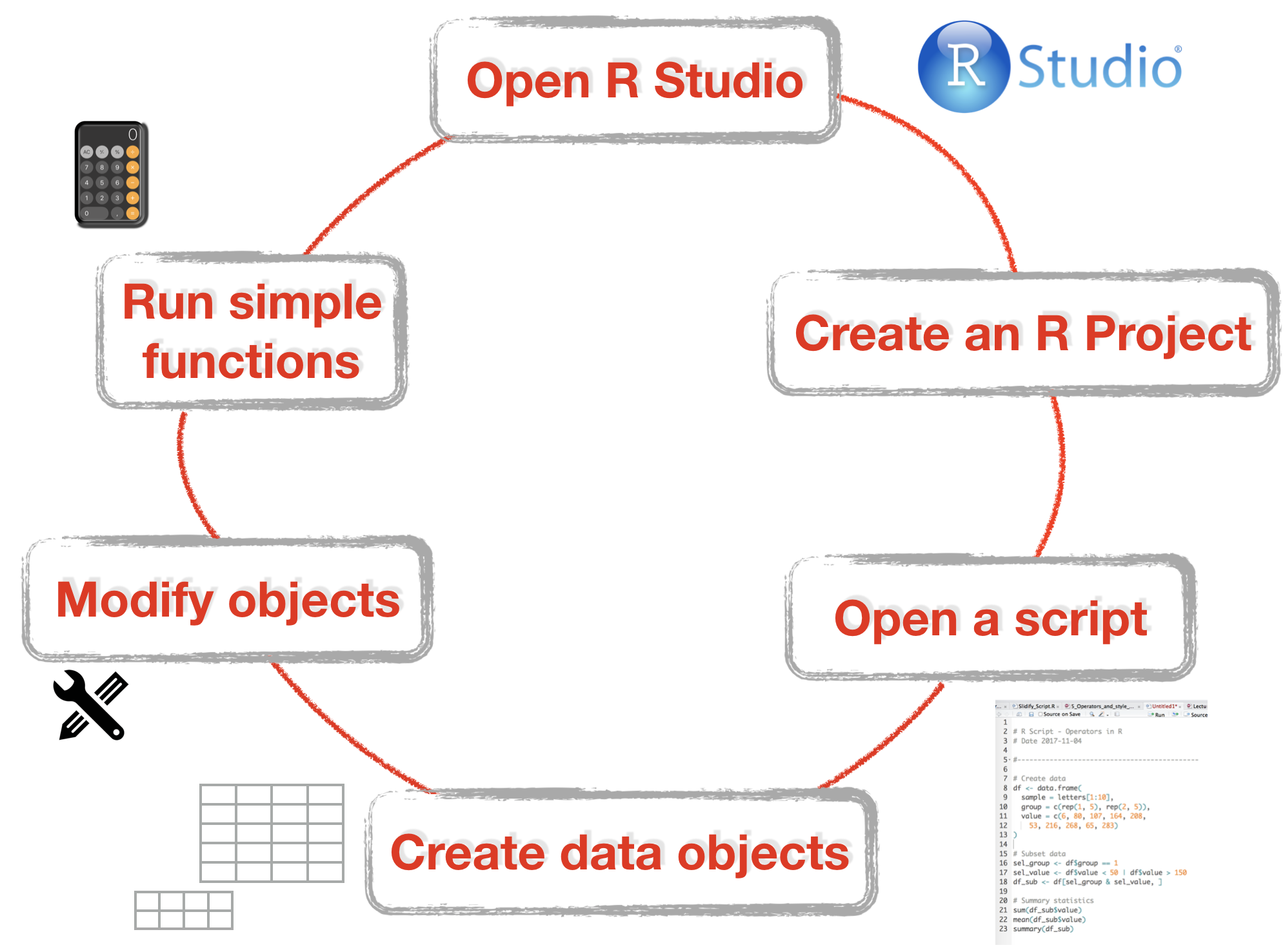


Data Analysis with R
4 - Operators
Saskia A. Otto
Postdoctoral Researcher
Operators

Overview of operators

Relational operators

- find out relation between two operands
- six relational operations are supported in R
- output is logical (TRUE or FALSE) for all of these operators
- work element-wise
| Operator | Usage | Description |
|---|---|---|
| < | a < b | a is LESS than b |
| > | a > b | a is GREATER than b |
| == | a == b | a is EQUAL to b |
| <= | a <= b | a is LESS than or EQUAL to b |
| >= | a > = b | a is GREATER than or EQUAL to b |
| != | a!=b | a is NOT EQUAL to b |
Example of relational operators

# Example for numbers
a <- 10
b <- 5
print(a < b) # less
print(a >= b) # greater or equal
print(a != b) # not equal
Example of relational operators

# Example for numbers
a <- 10
b <- 5
print(a < b) # less
## [1] FALSE
print(a >= b) # greater or equal
## [1] TRUE
print(a != b) # not equal
## [1] TRUE
Example of relational operators

# Example for numbers
a <- 10
b <- 5
print(a < b) # less
## [1] FALSE
print(a >= b) # greater or equal
## [1] TRUE
print(a != b) # not equal
## [1] TRUE
# Example for vectors
a <- c(7.5, 3, 5)
b <- c(2, 7, 5)
print ( a <= b ) # less or equal
print ( a != b ) # not equal
Example of relational operators

# Example for numbers
a <- 10
b <- 5
print(a < b) # less
## [1] FALSE
print(a >= b) # greater or equal
## [1] TRUE
print(a != b) # not equal
## [1] TRUE
# Example for vectors
a <- c(7.5, 3, 5)
b <- c(2, 7, 5)
print ( a <= b ) # less or equal
## [1] FALSE TRUE TRUE
print ( a != b ) # not equal
## [1] TRUE TRUE FALSE
Logical (boolean) operators

- work only for the basic data types (e.g. logical, numeric) and atomic vectors in R.


Example of combined boolean operators

x <- 1:5
x[ x < 4 & x >= 2]
## [1] 2 3
Example of combined boolean operators

x <- 1:5
x[ x < 4 & x >= 2]
## [1] 2 3
| Step | Usage | 1 | 2 | 3 | 4 | 5 |
|---|---|---|---|---|---|---|
| 1 | x < 4 | TRUE | TRUE | TRUE | FALSE | FALSE |
| 2 | ||||||
| 3 |
Example of combined boolean operators

x <- 1:5
x[ x < 4 & x >= 2]
## [1] 2 3
| Step | Usage | 1 | 2 | 3 | 4 | 5 |
|---|---|---|---|---|---|---|
| 1 | x < 4 | TRUE | TRUE | TRUE | FALSE | FALSE |
| 2 | x >= 2 | FALSE | TRUE | TRUE | TRUE | TRUE |
| 3 |
Example of combined boolean operators

x <- 1:5
x[ x < 4 & x >= 2]
## [1] 2 3
| Step | Usage | 1 | 2 | 3 | 4 | 5 |
|---|---|---|---|---|---|---|
| 1 | x < 4 | TRUE | TRUE | TRUE | FALSE | FALSE |
| 2 | x >= 2 | FALSE | TRUE | TRUE | TRUE | TRUE |
| 3 | x < 4 & x >= 2 | FALSE | TRUE | TRUE | FALSE | FALSE |
Element- vs. operand-wise operation

a <- c(TRUE, TRUE, FALSE, FALSE)
b <- c(TRUE, FALSE, TRUE, FALSE)
print(a | b)
## [1] TRUE TRUE TRUE FALSE
print(a || b)
## [1] TRUE
Other miscellaneous operators

- are similarly important for manipulating data.
| Operator | Usage | Description |
|---|---|---|
| : | a:b | Creates series of numbers from left operand to right operand |
| %in% | a %in% b | Identifies if an element(a) belongs to a vector(b) |
| %*% | A %*% t(A) | Performs multiplication of a vector with its transpose |
Other miscellaneous operators

- are similarly important for manipulating data.
| Operator | Usage | Description |
|---|---|---|
| : | a:b | Creates series of numbers from left operand to right operand |
| %in% | a %in% b | Identifies if an element(a) belongs to a vector(b) |
| %*% | A %*% t(A) | Performs multiplication of a vector with its transpose |
Example for %in%

a <- c(25, 27, 76)
b <- 27
print(b %in% a)
## [1] TRUE
print(a %in% b)
## [1] FALSE TRUE FALSE
Your turn...
Quiz 1: Relational operators
What does the following operation return (try to find the answer without using R):
a <- c(6, 80, 107, 164, 208, 53, 216, 268, 65, 283)
a < 60
- NA
- a numerical vector containing 6 and 53
- TRUE
- FALSE
- a logical vector with TRUEs and FALSEs
R checks for each element in a whether its value is less than 60 and returns a TRUE or otherwise a FALSE. As we have 10 elements in a the returned logical vector has also 10 elements.
Quiz 2: Relational operators
How many TRUEs would you get from the following operation (try to find the answer without using R):
a <- c(6, 80, 107, 164, 208, 53, 216, 268, 65, 283)
a <= 80
- 1
- 6
- 4
- 3
R applies the operation element-wise: 6 <= 80? 80 <= 80? 107 <= 80?...
Four elements have values that are TRUEly less than or equal to 80, i.e. 6,53,65, and 80.
Quiz 3: Relational operators
How many TRUEs would you get from the following operation (try to to find the answer without using R):
a <- c(16, 47, 207)
b <- c(0, 49, 410)
a <= b
- 1
- 2
- 5
R applies the operation element-wise in both vectors: 16 <= 0? 47 <= 49? 207 <= 410?
Two values in a are TRUEly less than or equal to the corresponding values in b, i.e. 16 and 47.
Quiz 4: Relational operators
What do the following operations on these vectors return:
a <- c(4, 5, 1, 8, 8, 10)
b <- c(0, 0, 3, 6, 7, 9); c <- 3
- a[a < b]
- b[b == c]
- sum(c >= b)
If a vector is shorter than the other it gets recycled for the element-wise comparison
Recall,
a < breturns a logical vector of length a and b (=c(FALSE,FALSE,TRUE,FALSE,FALSE,FALSE)), which you then use to subset the vector a. Only the 3rd element in a (=1) is TRUEly less than the corresponding element in b (=3) and its number is then returned: 1c gets first recycled (meaning that the value 3 gets repeated 6 times) for the element-wise comparison, in which only one element has the same value as c and the value of that element is then returned: 3.
c >= breturns a vector with 3 TRUEs and 3 FALSEs. Why? When you calculate the sum, R coerces the elements to integers (recall, TRUE turns into 1 and FALSE into 0), so the correct answer is 3.
Logical operators
For 6 days it was measured whether it was sunny (sunny = TRUE) and whether it was hot (hot = TRUE). Now we want to check for several conditions (try to to find the answer without using R):
sunny <- c(TRUE, TRUE, TRUE, FALSE, FALSE, FALSE)
hot <- c(FALSE, TRUE, FALSE, TRUE, FALSE, TRUE)
Quiz 5: Logical operators
What does the following return?
sunny <- c(TRUE, TRUE, TRUE, FALSE, FALSE, FALSE)
hot <- c(FALSE, TRUE, FALSE, TRUE, FALSE, TRUE)
sunny & hot
- a vector of length 12 (with 6 TRUEs and 6 FALSEs)
- a vector of length 6 (with 1 TRUE and 5 FALSEs)
- a vector of length 6 (with 3 TRUEs and 3 FALSEs)
& is an element-wise AND operator: a TRUE is only returned if it is sunny and hot (both TRUE)
Both vectors have a length of 6 (6 days), hence,the returned vector has also 6 element. It contains only 1 TRUE (in position 2) as only at day 2 the weather was sunny AND hot.
Quiz 6: Logical operators
What does the following return?
sunny <- c(TRUE, TRUE, TRUE, FALSE, FALSE, FALSE)
hot <- c(FALSE, TRUE, FALSE, TRUE, FALSE, TRUE)
sunny | hot
- a vector with 6 TRUEs
- a vector with 5 TRUEs and 1 FALSE
- a vector with 1 TRUE and 5 FALSEs
| is an element-wise OR operator: a TRUE is returned if it is sunny or hot (at least one of both is TRUE).
Every day it was sunny or hot, except for day 5 (hence, here a FALSE in the returned vector).
Quiz 7: Logical operators
What does the following return?
sunny <- c(TRUE, TRUE, TRUE, FALSE, FALSE, FALSE)
hot <- c(FALSE, TRUE, FALSE, TRUE, FALSE, TRUE)
sunny || hot
- FALSE
- TRUE
The question to this operation would be: Was is for any of the 6 days at least sunny or hot?
|| carries out a logical OR operation consolidated for all elements: first the OR operation is carried out element-wise and then it is checked whether at least one of the returned element is a TRUE.
Quiz 8: Combining operators
Which values do you get from the following vector:
a <- c(6, 80, 107, 164, 208, 53, 216, 268, 65, 283)
- a[a > 50 & a < 60]
- a[a > a[5] & a < a[8]]
- sum(a > 250 | a < 100)
- sum(a[a %in% 1:60])
- 53.
- 216.
- 6.
- 59.
Quiz 9 - Challenge: Using operators for subsetting
df <- data.frame(
sample = letters[1:10],
group = c(rep(1, 5), rep(2, 5)),
value = c(6, 80, 107, 164, 208, 53, 216, 268, 65, 283)
)
Subset this data frame using the operators you just learned:
- Extract all observations from group 2
- Extract all observations where values are greater than 150.
- Extract all observations from group 1 where values are less than 50 or greater than 250.
- Extract all observations that have the letters "a", "c", "g", or "j"
(for a hint press p and for a solution code see last slide)
p
Well Done!!!! You mastered the most important R basics that are fundamental for all that follows.
You are now able to ...

How do you feel now.....?
Totally confused?

Read up on R operators in this very nice tutorial provided on the tutorialcart website: https://www.tutorialkart.com/r-tutorial/r-operators/.
Totally bored?

Don't worry! Soon you won't be bored anymore!!
Totally content?
Then go grab a coffee, lean back and enjoy the rest of the day...!

Thank You
For more information contact me: saskia.otto@uni-hamburg.de
http://www.researchgate.net/profile/Saskia_Otto
http://www.github.com/saskiaotto

This work is licensed under a
Creative Commons Attribution-ShareAlike 4.0 International License except for the
borrowed and mentioned with proper source: statements.
Image on title and end slide: Section of an infrared satallite image showing the Larsen C
ice shelf on the Antarctic
Peninsula - USGS/NASA Landsat:
A Crack of Light in the Polar Dark, Landsat 8 - TIRS, June 17, 2017
(under CC0 license)
Solution - Quiz 9
1.Extract all observations from group 2.
sel_group <- df$group == 2 # returns a logical vector
df[sel_group, ] # column index is empty as we want all columns
2.Extract all observations where values are greater than 150.
sel_value <- df$value > 150
df[sel_value, ]
3.Extract all obs. from group 1 where values < 50 or > 150.
sel_group <- df$group == 1
sel_value <- df$value < 50 | df$value > 150
df[sel_group & sel_value, ]
4.Extract all observations that have the letters "a", "c", "g", or "j".
sel_sample <- df$sample %in% c("a", "c", "g", "j")
df[sel_sample, ]